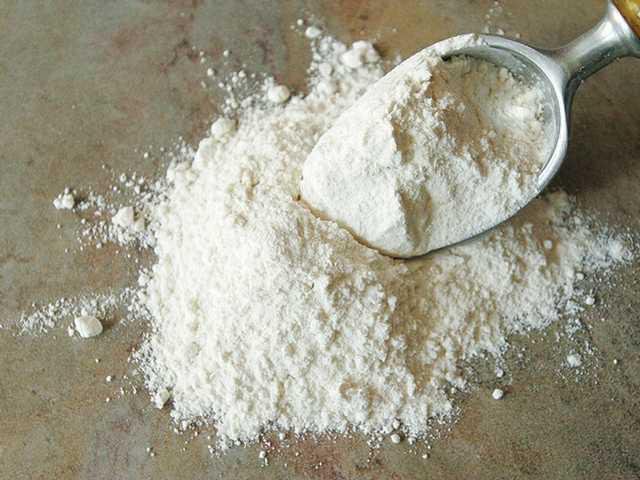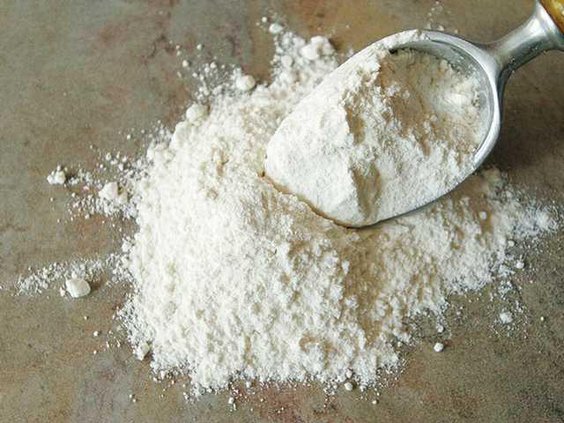Types of flour
All-purpose flour: Use for cakes, breads, pies, cookies, quick breads and muffins. The protein level is 11.7 percent.
Bread flour: A higher protein level gives more support to nongluten flours like rye; it also helps structure of whole-grain breads. Makes excellent pizza crust and artisan loaves, which have a high water content. The protein level is 12.7 percent. Use for breads and pretzels, combined with whole-grain or nongluten flours.
Cake flour: Bleaching changes wheat starches, allowing them to absorb more liquid and rise slightly higher. The protein level is 8 percent. Use for cakes and some muffins.
Pastry flour: Lower protein yields a more tender product without artificial chemicals. The protein level is 9 percent. Use for cakes and pastry.
Self-rising flour: This is a low-protein flour that has baking powder and salt added to it. The protein level is 7 to 8 percent.
Whole-wheat flour: Ground from the entire wheat berry, whole-wheat flour contains bran, germ and endosperm. The oils in the germ can go rancid, so whole-wheat flour should be stored in an airtight container. The protein level is 15 percent.
King Arthur Flour Co.
Holiday baking season is quickly approaching. And whether you are ready to create cookies, cakes or breads, there is a perfect flour out there for your special recipes.
So, when you enter your local grocery store and head toward the baking aisle, you better know your flours - because they aren't all the same.
Then there are regional favorites like White Lily in the South and King Arthur in the Northeast. These flours also vary when baking because of wheat type along with protein and gluten levels.
"Basically, the protein level in flour determines how well the flour can form gluten, and gluten is good for some baked goods and bad for others," said Allison Furbish, media relations manager for King Arthur Flour. "So, for example, a loaf of yeast bread - which you want to be able to rise high - you would want to use flour with a fairly high protein level because that high protein level allows this matrix, this kind of web of gluten, to form and hold together. So as the bread rises and fills with the gases that make it rise, that gluten can actually stretch and allow the bread to rise and also hold it up while it does that."
Furbish added that if you used a low-protein flour for yeast bread, it wouldn't bake correctly.
"It just wouldn't be able to rise because as the gases expand and try to rise there wouldn't be enough gluten there to give it the structure to hold its shape," she said.
King Arthur Flour, based in Vermont and the oldest flour company in America, has very strict controls on the protein content for all of its baking flours. The strict controls lead to a more consistent flour.
"We have very strict levels for our flours and that varies from flour to flour. ... Our all-purpose flour is a higher protein level than our pastry flour," Furbish said. "Our protein level is not allowed to vary more than two tenths of a percent, so our all-purpose flour is always going to be about 11.7 percent protein.
White Lily Flour, based in Tennessee, uses soft winter wheat to create its flour while King Arthur uses hard red wheat.
"The difference in White Lily Flour and other flours is that it is 100 percent soft wheat, which makes it more like cake flour than regular all-purpose flour made from soft wheat," said Linda Carman, spokeswoman for White Lily Flour. "You need more White Lily flour in a recipe because softer wheat flours absorb less liquid than hard wheat flours. So, most standard recipes are tested with an all-purpose flour, which is a blend of hard and soft wheat. If you added the same amount of liquid and the same amount of flour, the dough would be softer with White Lily flour than it would be with an all-purpose."
According to the White Lily Web site, soft winter wheat has a low protein content and low gluten content and is recommended for cakes, biscuits and quick breads. The flour has a low in protein content because the soft wheat is pure - not blended with hard wheat.
"All I know is the only kind I use is White Lily," said Peggy Truelove, baker and owner of Truelove Celebrations in Gainesville. "It just seems to work better in cakes; the cakes rise better. It's a finer flour, maybe."
Truelove added that she never uses cake flour - she uses all-purpose for her cupcakes and cakes.
"None of my recipes call for cake flour," she said. "I don't know what the differences are in cake flour ... one time I bought it I didn't particularly like the way it came out. All my recipes call for all-purpose and self-rising, and I prefer White Lily over some of the other brands like Pillsbury. I don't know why; that's what I grew up with I guess."
Furbish said cake flour is good for cakes and muffins but that she doesn't use it personally.
"Cake flour by definition is bleached flour," Furbish said. "Bleaching actually changes the starches in the wheat and allows it to absorb more liquid and rise higher. With almost any cake you can use all-purpose flour, or, if you prefer, you can use a pastry flour. You'll still get a softer, more tender cake with pastry flour and that is what I personally would opt for if I were going to do that.
"Our flours are always unbleached and unbromated," she said. "The bleaching is completely unnecessary; flour will lighten on its own if you give it a few weeks' time, and we simply give it that time. Bromates are called potassium bromate, and it's something that is used to make a less consistent flour seem like it behaves more consistently."
Something that has gained in popularity is organic flour for baking, according to Furbish.
"You can substitute organic and use it the exact same way," Furbish said.

